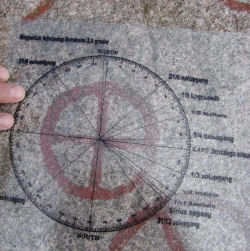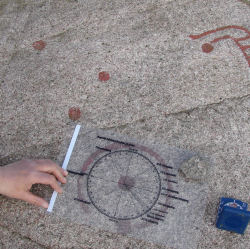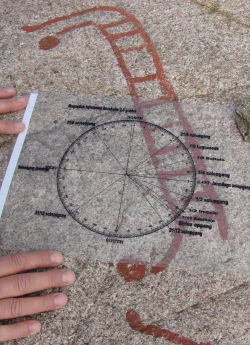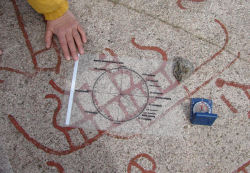by Jeanne Cordua
(Article published in the local amateur archeologer’s magazine Guldgubben, autumn 2008)
If you have been standing looking down at the strange stone carving wheel crosses, especially as seen at Lille Strandbygård, you might simply assume that they have been carved haphazardly – that the ancient people did not care, because they were “primitive” – nothing can be further from the truth!
As our local archaeologist, Mogens Jensen, has often pointed out, the Bornholm stone carving ships show clear sailing directions, particularly towards sunrise and sunset at midsummer solstice, and he has done a great and important archeoastronomical piece of work, especially at the area Madsebakke.
For many years I have also been interested in the Bornholm stone carvings, grave mounds and standing stones, and with my friend, Birgit Bertelsen, I have gone round the island to study them. If the ships sailed in the directions of the ancient (Celtic) holidays – how about the wheel crosses – where did they point?
As I live relatively close to the site Lille Strandbygård, I got the idea after reading an article about the American “Medicine wheels” – namely to make a kind of “holiday compass rose”, that I could place upon the wheel crosses and then decide by aid of a compass what prevalent directions the arms of the crosses were pointing towards.
To find the correct directions I used as a source ”Stjerner, sten og stænger” by E. Laumann Jørgensen (to my knowledge, no English version) and then I added ca. 2 degrees to make it match Bornholm in a middle height above the sea. As the paint stripes are quite broad on the existing wheel crosses, some metres to or fro would hardly make any difference, I hope.
Let me begin with an orientation picture of the Lille Strandbygård carving (inserted numbers refer to texts below)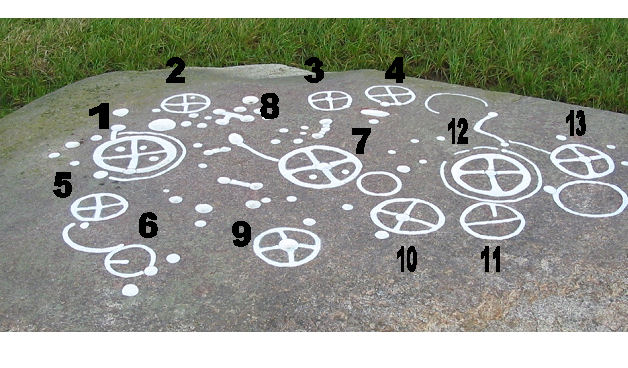
Here follow my findings:
| 1 Orientation east-west with clear north. U. left cup mark and cup mark just outside E. left pointing at sunset midsummer. Lower cup mark right sunrise midwinter. Besides, holidays at 1/11, 1/2 and rise of Sirius fall within the field. |
| 2 Clear marking east-west. Cup mark E. right may mark direction of Big Dipper – north at the time was not as now at Polaris, but between Polaris and Little Bear because of precession of equinoxes. Cup marks below outside wheel cross mark direction towards sunrise midwinter – plus perhaps a couple of other holidays. |
| 3 Sunrise at ca. 1/4 and 21/12 – big cup mark lower right. Besides, direction can be seen in oblong cup mark below right. Clear direction north-south. |
| 4 Clear east-west – north-south. Besides sunset 21/12. |
| 5 North-south-west clear. The stroke lower left may give dirction to no. 6, besides sunset 21/12. East cross arm pointing to sunrise 1/4. Cup mark outside ring lower left may be sighting line to visible star in southwest or perhaps the southern moon standstill. |
| 6 Only two clear directions, namely straight west on the cross arm and the big cup mark lower right, pointing to sunrise in the period from fra 21/12 – 1/2. Please note that the curved line from no. 5 continues in over no. 6. Has a connection been shown? |
| 7 Reasonably clear orientation N-S E-W. |
| 8 Small cross of cup marks between figs. 2 and 7. Oriented towards sunrise and sunset at summer and winter solstices. |
| 9 Oddly “twisted” wheel cross with orientation towards sunrise ca. 1/3. The upper cross arm may be oriented towards the Big Dipper – see also fig. 2. As we do not know at what time at night the fugure was in use we must remember that the northern stars rotate around north like a cosmic clock. |
| 10 Though the wind made my model fly, you can see that the right arm on the cross points towards sunrise at ca. 1/2. Cupmark outside lower right points towards sunset 21/12. |
| 11 Clear east-west direction. The little arm at top may again point towards the Big Dipper. See also figs. 2 and 9. |
| 12 East-west clear, otherwise cup mark outside field with possible direction towards northern stars, see figs. 11, 2 and 9. Might one imagine that the circle around the wheel cross marks some kind og time period? |
| 13 Upper cross arm possibly towards norhtern stars, see figs. 11, 2 and 9. Right cross arm pointing to sunrise at ca. 1/5. Besides, cup mark outside figure – may point to sunrises at 21/6 and 1/3. |
My used “holiday compass rose”
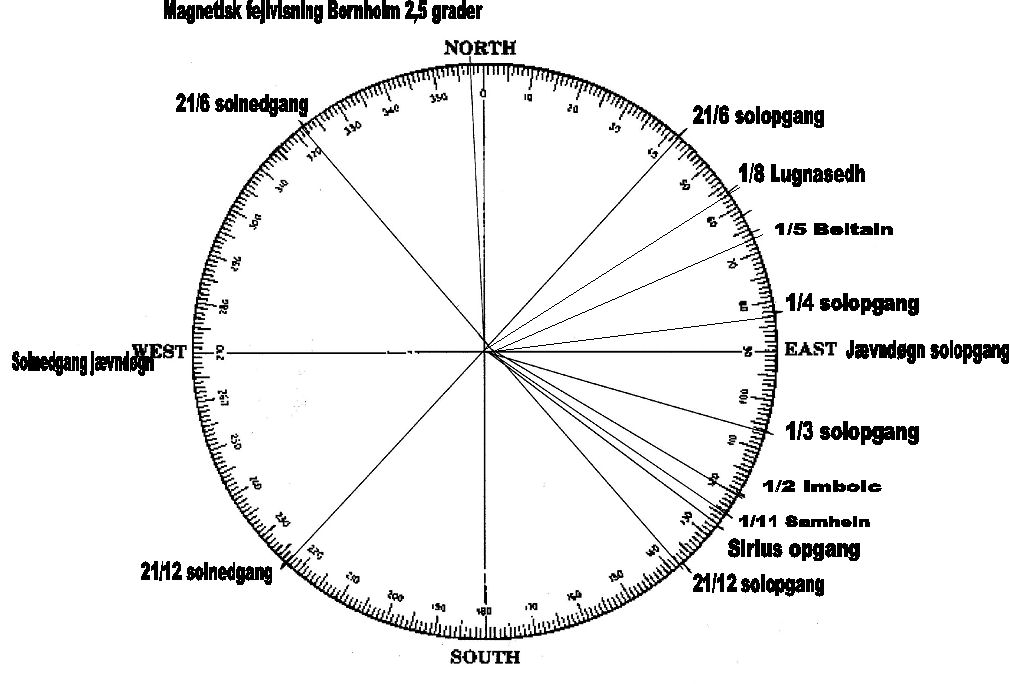
Measurements at Blåholthuse stone carving site, 2008:
The same method as above has here been used ont the two wheel crosses as well as a couple of ships at the stone carving site Blåholthuse:
First you see the rock itself with numbers inserted, referring to the texts below:
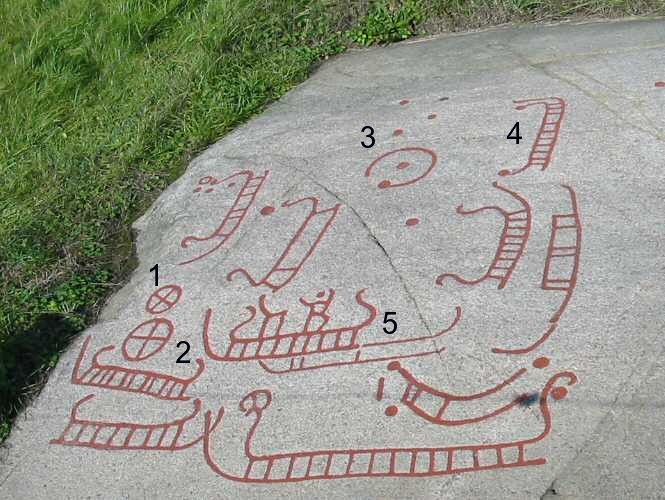
|
This wheel cross shows in particular sunrise at about 1/5 – an ancient celtic holiday. |
| Here directions are excactly north-south-east-west. |
| 3 At first glance no directions. But look at the cup marks above and below, and they make point towards sunrise at 21/12 and sunset 21/6. Perhaps the shape itself is a marker for when a certain holiday was to be held – “follow the circle and do something at the cup mark”…? |
| 4 A strange ship that seems to sail north-south. The stern points to sunrise on 21/12. Perhaps the voyage from midwinter darkness has begun – perhaps these are “ships of death” – the realm of death lay in many mythologies in the north, about which the eternal northern stars were turning… |
| 5 This ship with 2 men (?) sails from sunrise on 21/6 and salutes midsummer. The late professor P.V. Glob thought one was standing with a lur in his hand. They are sailing towards sunset on the 21/12. More ships are sailing in this direction, please see main picture. |
Measurement at Baunehøj near Nylars
This rock is usually not painted, but has public access. See a painted version here:
My measurements are taken from the photo on the sign at the rock. I have used compass to clarify the directions just lik at the other stone carvings.
I have worked from the large, clear cup mark in the centre, and to my great joy there were clear directions north-south-east-west as well as a possible sunrise in the period from 1/11-21/12 and rise of Sirius. This must be taken with some consideration, as I was working with an illustration of the rock. Please click picture for larger version!
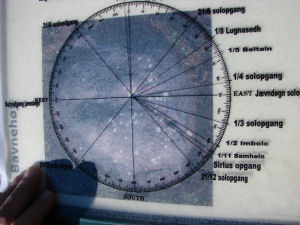

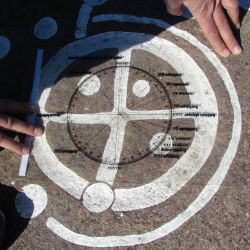
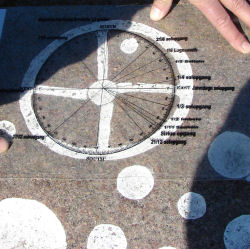
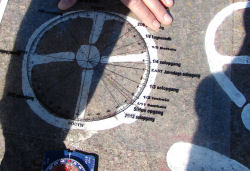
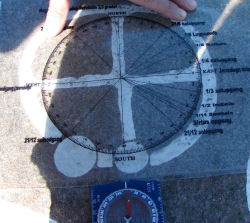

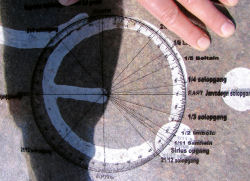
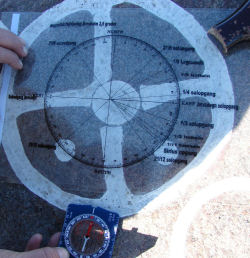
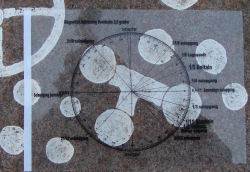
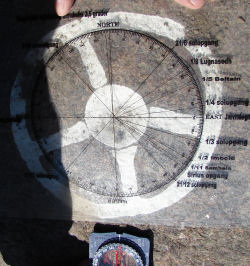
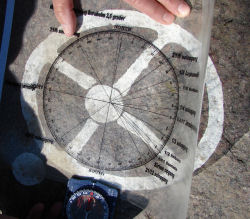
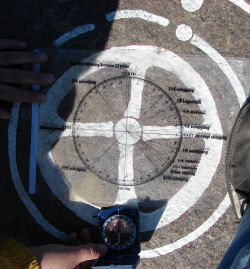
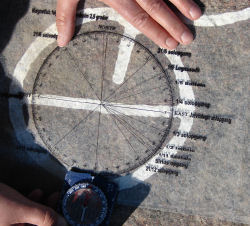
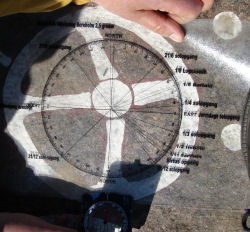
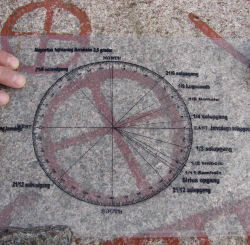 1
1